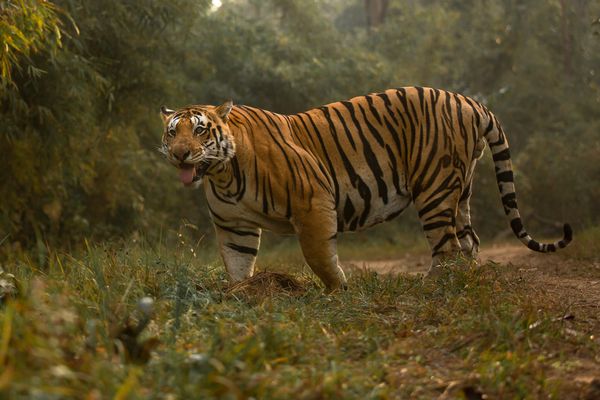flora & fauna in Kanha National Park
Kanha’s sal and bamboo forests, rolling grasslands and meandering streams stretch over 940 sq km in dramatic natural splendour. This is original Kipling country,of which he wrote so vividly in his Jungle Book. The same abundance of wildlife species exists today in Kanha National Park, which forms the core of the Kanha Tiger Reserve created in 1974 under Project Tiger. The park is the only habitat of the rare hardground barasingha (Cervus Duvaceli Branderi).
In the 1930s, the Kanha area was divided into two sanctuaries: Hallon and Banjar, of 250 sq km and 300 sq km each. Though one of these was subsequently disbanded, the area remained a protected one until 1947. Depletion of the tiger population in the years that followed led to the area being made an absolute sanctuary in 1952.
By a special statute in 1955, Kanha National Park came into being. Since then, a series of stringent conservation programmes for the protection of the park’s flora and fauna has given Kanha its deserved reputation for being one of the finest and best administered National Parks in Asia, an irresistible attraction for all wildlife lovers and a true haven for its animal and avian population.
Kanha’s flora, or plant life, is the underpinning of the park’s entire ecosystem. Tigers could not live here without prey, such as chital, sambar, wild boar, and barasingha. These animals, in turn, could not subsist without the forage that the plant life furnishes them. Langurs, sloth bears, and birds depend on fruits, flowers, nectar, and forbs for survival. Insects, spiders, and trees have a complex, interdependent set of relationships, in which spiders help to regulate the defoliant pressures on trees by controlling the insect population. Termites, whose digestive system turns decaying vegetation into soil-enriching nutrients, are a major item in the sloth bear’s diet, exemplifying dynamic linkages among insects, plant life, and one of the park’s major mammals. In these and many other similar examples, an ecosystem approach is, as always, the key to a more sensitive, accurate understanding and appreciation of the park.

- Sal : Zone with over 50% sal trees, Shorea robusta mostly in valleys (18.08%)
- Sal / Bamboo : mainly lower slopes (5.07%)
- Mixed sal / Bamboo : (7.34%)
- Mixed : upper plateaux areas (16.05%)
- Mixed Bamboo : (24.8%)
- Valley Grasslands : (6.4%)
- Grasslands with mixed forest tree species : (2.88%) to Agriculture and human habitation (3.5%)
- Dadar (plateau) grasslands : (2.61%)
Another, more immediately helpful classification of Kanha habitats is that of Canadian biologist Renata Jaremovic, who is now based in Australia and who carried out a research project in Kanha in the mid-1990s. She identifies the following six readily recognizable habitats within the park, together with the major mammals that make use of them.
1. Sal Forest: Chital, sambar, wild boar, langur, tiger, leopard, jungle cat, sloth bear, wild dog.
2. Sal | Mixed Bamboo: Sambar, gaur, wild boar, langur, tiger, leopard.
3. Miscellaneous Mixed Bamboo: Same species as above.
4. Miscellaneous Mixed Deciduous: Sambar, gaUr, chow singha, sloth bear, langur, tiger, leopard.
5. Grassland: Chital, barasingha, blackbuck, chowsingha (on plateaux), wild boar, langur, tiger, wild dog.
6. Habitation: Used by species accustomed to humans.
The sal tree (Shorea robusta) and various species of bamboo (especially Dendrocalamus strictus) are the most prominent features of Kanha’s extensive flora. These species have complex, distinctive flowering patterns, with sal blooming annually over a period of several months and deciduous throughout the year, and many bamboo species flowering only once during an extremely long life cycle that may span several decades.Officials have estimated that Kanha is home to more than 600 species of flowering plants. A list of 50 water plants was included in the Kanha Management Plan of 1988-89 (Kotwal and Parihar, 1989). Aquatic plants such as water lilies are of considerable importance to the barasingha.






